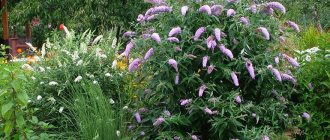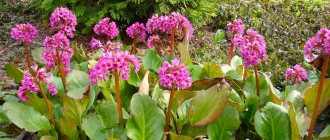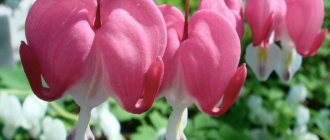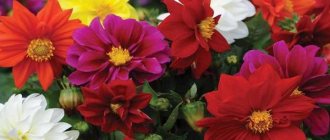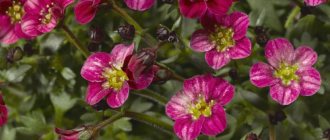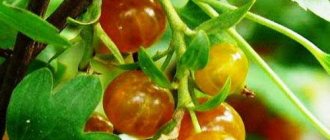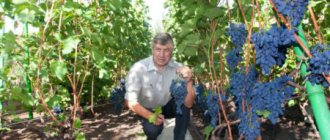Flowering golden currant
Black, red and white currants are the most common fruit bushes in summer cottages. But not everyone even suspects the existence of the golden one, although it appeared in our country back in the eighteenth century.
Some, seeing it for the first time, mistake it for a hybrid of gooseberries and currants. Indeed, the leaves of this crop are very similar to gooseberries, however, this is a completely independent type of shrub. It is grown both for its tasty and healthy fruits and as an ornamental plant.
External description and characteristics of golden currant
A shrub with a root system extending to a depth of 1.5 m. Erect branches up to 2.5 m long, overloaded with bunches of berries, bend to the ground. The bark is red. The shape of the leaf blade resembles a gooseberry leaf.
Golden currant belongs to the Gooseberry family . This is a perennial deciduous shrub. It blooms profusely for almost 20 days with yellow flowers. The culture got its name “golden” for their rich color. The harvest is not affected by frost, as the flowers bloom in the last days of May.
The color of the berries is very diverse. In some varieties it may be burgundy, in others black, in others orange. Productivity is high. 5-15 kg of fruits are collected from one golden currant bush. The advantage of this variety of currant is its low shedding. This allows you to harvest the entire crop at one time.
Characteristics of berries:
- the shape is different, depending on the variety, it can be teardrop-shaped, round-oval, round;
- berries weigh from 1.5 to 3 g;
- covered with a tough skin;
- the pulp has a sweet and sour taste;
- perhaps a blueberry or nutmeg aftertaste.
The bushes begin to bear fruit at the age of 3. The most productive are 5-7 year old shoots. They produce the most berries.
Application
The shrub has a dual purpose. It is grown as a fruit and berry crop and for decorating streets, parks, and public gardens.
As a fruit and berry crop
The harvest of golden currants is used for winter preparations. They make preserves, marmalade, compote, and freeze them. They make excellent homemade wine.
Use in landscape design
The high decorative value of the shrub makes it possible to use golden currants in the design of streets, squares, and parks. Their bushes are decorated from spring to autumn. Arched long branches reach 2 m in height. In the spring they are covered with clusters of golden flowers for three whole weeks.
In summer, the branches are sprinkled with a scattering of shiny black berries. In autumn, the leaves turn purple. Gardeners form picturesque hedges from golden currants. A green fence decorates the landscape and protects from noise, dust, and wind.
Beneficial features
Golden currant has many beneficial properties for the human body:
- antioxidant properties;
- strengthening the immune system;
- decreased blood glucose levels;
- cleansing blood vessels from cholesterol;
- improving the functioning of the heart and the entire system;
- saturating the body with vitamins.
How to grow golden bush
It is not difficult to breed the golden variety in the country. Although for good fruiting in the garden it is worth planting 2-3 seedlings. The more there are, the better the pollination.
Suitable climate
All varieties of golden currant are acceptable for the Moscow region. This species can adapt to extreme climatic conditions. The climate of central and southern Russia is suitable for growing and harvesting. The shrub freezes slightly and dies at temperatures of -40 °C. Varietal currants can withstand southern heat and drought.
Optimal timing
In autumn, golden currant seedlings are planted in the garden from September to October. At least 1-1.5 months must pass before frost. In the spring they are planted after the ground has thawed.
Site selection and landing scheme
Golden currant is remarkable because it grows and bears fruit in any soil. It can be planted near a fence or building. Areas with light shade are more suitable for planting, but the shrub can also tolerate bright sun and shade.
See also
How to properly store fresh black and red currantsRead
Planting scheme, requirements for the landing pit:
- width - 0.5 m;
- depth - 0.5 m;
- the soil mixture for backfilling consists of humus (1 part), garden soil (1 part), ash (1 tbsp.), superphosphate (200 g);
- the distance between planting holes is 2.5-3 m.
Principles and nuances of care
Shrub care comes down to more than just watering. Bushes need to be formed, fed, and treated if necessary.
Watering
Golden currants tolerate short-term drought well. If precipitation falls, then it has enough rain. Water the bushes only during prolonged drought. 4 buckets of water are enough for one bush.
Application of fertilizers
During the season, golden currant bushes are fed three times. For the first feeding, urea is used. Before watering, granules (30 g/m²) are scattered over the area of the trunk circle and the soil is lightly loosened.
The second feeding is carried out immediately after picking the berries. During it they use:
- superphosphate 35 g/m²;
- potassium nitrate 25 g/m².
The last time fertilizer is applied is in the fall. They use manure. It is laid out around the bush. Organic fertilizer can be applied every other year.
Digging row spacing
The soil between the bushes is dug up annually. Digging is needed to prevent fungal diseases and pests. With its help, mineral fertilizers and rotted manure are added to the soil.
Weeding and loosening
Weeds are removed as they appear. The soil is loosened after rains and waterings. In autumn, the soil is cleared of fallen leaves, barrier irrigation is carried out and loosened. The procedure is especially important for young bushes. If there is no loosening, the soil becomes covered with cracks in the summer, which causes damage to the roots and slower growth.
Forming a currant bush
Two-year-old bushes require formative pruning. Thereafter it is carried out annually. In the second year after planting, shoot growth is stimulated:
- the weak are cut out;
- the remaining branches are shortened by ⅓ of the length.
After a year, all annual shoots are left from the three-year-old bush. Branches that have grown over the summer are cut out except for the 3-6 most powerful ones. The purpose of such pruning is to form a bush consisting of 20-40 branches of different ages. In the 5th year, 4-year-old shoots are removed.
Mature bushes (10 years and older) require anti-aging pruning. It is carried out by trimming the bush to a stump or cutting out all shoots older than 8 years. The older the bush, the more dramatic it is. All types of work are carried out in early spring before the buds swell or after leaf fall in the fall. Decorative pruning is used if the bushes are an element of landscape design.
Treatment against pests and diseases
Golden currant bushes are rarely treated. All varieties have high resistance to viral and fungal infections. To maintain the health of the bush, it is enough to follow the rules of agricultural technology and perform a number of mandatory measures:
- annual sanitary pruning;
- formative pruning;
- removing fallen leaves;
- digging between rows.
Growing shrubs
In regions of mid-latitude and southern regions, planting in open ground is carried out without restrictions. In colder areas, the range boundaries do not cross the boundaries of areas where winter temperatures drop below minus 40.
Read about the use of ammonia against aphids at the link.
There are no special requirements for soil. On clay soils where moisture retention occurs, it is not worth planting golden. Their yield will be much lower than planned. But if there is no other land, then you can start preparing it, which consists of ensuring good drainage to the soil.
How to plant a plant correctly. When does it begin to bloom and bear fruit?
For those who deal with black or red currants, this procedure will not be difficult. For beginners, it is important to consider the following.
Before planting, you need to prepare holes for planting. They should have the following dimensions - 50x60 cm. We fill the holes one third with either ready-made compost or rotted manure. To this substance you need to add 200 grams of superphosphate or ash and mix everything.
The distance between adjacent holes should not be less than three meters, especially in relation to tall varieties.
During planting, the root collar needs to be buried 5-7 cm into the soil. This will accelerate the formation of adventitious roots and the growth of young shoots.
Scheme for planting golden currant bushes.
The soil around the sprout needs to be mulched. The sprout itself is cut to four buds.
Selection of seedlings
First of all, you need to decide why you need a seedling. For decorative purposes, you can choose almost any variety, even one not zoned in your region. But if you want to get a big harvest, then there are some nuances of choice:
- Experts advise choosing a seedling in nurseries.
- The next piece of advice is to choose a zoned variety adapted specifically to your climate zone. After all, varieties intended for southern regions will not yield crops in latitudes with a more severe climate and vice versa.
- Appearance. When purchasing a seedling, you should have an idea of what the bush will be like as an adult. This is useful when a plant is purchased for decorative purposes.
- Productivity. Of course, each variety has its own yield indicator, but the quality of care should not be ignored. But there is a small drawback - it is hardly possible to exceed the yield limits of the variety. For example, if it is said that the yield is no more than 6-8 kg per bush, then you will not be able to get more, no matter what you do. Therefore, check this indicator at the purchase stage so as not to be disappointed.
- Care. All golden varieties are extremely unpretentious. Therefore, experts advise choosing the largest-fruited and most productive varieties available in your region.
Nurseries usually sell seedlings in pots. If they are not available, then choose two or three year old ones with well-developed roots.
Time and place of landing
Seedlings are usually planted in the fall. Although many gardeners do this in the spring. The main thing to remember is that the landing should be done:
- In autumn - plant after the end of sap flow.
- In spring - on the contrary, before it begins. In addition, in the spring you need to make sure that frost does not return. Otherwise, the seedling may die.
As for the planting site, you can choose any one, the main thing is to avoid clay soils with high humidity. The best option is a well-lit or slightly shaded area with fertile soil.
The following fact speaks in favor of a sunny place - fruit ripening occurs faster, and the yield is slightly higher.
Control measures and folk remedies for aphids are described here.
Features of culture propagation
You can grow seedlings from seeds. This is the most common method of propagating golden currants. The procedure is simple, but time-consuming:
- seeds are taken from ripe berries;
- for 2 months they are sent for stratification in the cellar, where the temperature is not higher than 4 °C, they are stored in a container with wet sand;
- in autumn they are sown in the ground.
You can propagate golden currants vegetatively:
- layering;
- dividing the bush;
- green cuttings.
Reproduction. By what methods can it be propagated? How to propagate green cuttings correctly
There are several methods of reproduction.
Seeds - sowing is done in the fall. Before planting, the seeds need to be stratified in wet soil for 4 months at a temperature of 2-5 above zero. The similarity of the seeds is 80%, which is quite a lot.
The downside is that with this method there is no guarantee that the characteristics of the variety, especially hybrids, will be preserved.
Dilute by layering - the method is considered quite reliable. It’s done like this: we dig a groove 10-15 cm long near the bush. A young shoot is placed in it and completely covered with earth. Leaving only the top of the head on the surface. Everything is watered. Over the summer, the shoot takes root and in the fall it can be separated from the main bush and replanted.
It can be propagated by green cuttings - the method is not very reliable due to the fact that not all cuttings root. They are harvested from 4-year-old shoots in the dormant stage (October). Cut off sprouts as thick as a pencil with 4-5 buds, preferably root ones.
Read how to fight aphids on black currants here.
Store in the refrigerator in moistened sand.
Planting in spring, in April. In fertilized soil, fertilizing (ash, humus and superphosphate) is applied two weeks in advance.
The cutting is placed in the hole at an angle of 45°, leaving only 1-2 buds at the top. We water it. We mulch.
The soil around the plantings should be constantly moist.
Some gardeners place the cuttings in water in February and wait for the roots to appear, after which they plant them in pots. Plant in open ground in May, this way you can achieve a higher percentage of rooting. It would be optimal to use peat pots; planting in the ground can be done in them, thereby further increasing the possibility of establishment.
Diseases and pests characteristic of the variety, their control
Diseases on currants are rare, but they do occur. In unfavorable years, the bushes are attacked by pests.
Common spider mite
The pest weakens the plant; if it is heavily infested, the leaves on the bush dry out, and the berries ripen later. Signs of spider mites on golden currants can be noticed in May before flowering. The leaves on the bushes turn from green to brown or whitish. You can see mites from the back of the leaf blade.
The pest is destroyed with Karbofos (50%). The bushes are sprayed after flowering. Leaves damaged by insects are torn off and burned. The soil in the tree trunk circle is dug up. Instead of Karbofos, use garlic infusion and sulfur preparations.
Currant bud mite
A very dangerous pest. You can find out about infection by signs of its vital activity. They appear in early spring and during the growing season:
- swollen kidneys;
- deformed apical leaves.
There are several methods to combat ticks. In early spring, infected shoots are identified by the buds, cut out and burned. During flowering, currant bushes are treated with a solution of colloidal sulfur.
Great currant aphid
The fact that a golden currant bush has been attacked by aphids is recognized by twisted, wrinkled leaves. Turning them over, they see small green insects on the back side of the leaf plate. They suck out juice and carry infection.
See also
Description and characteristics of black currant variety Binar, care and cultivationRead
To destroy the pest, the bushes are treated with:
- Karbofos solution;
- "Nitrafen" (3%).
Anthracnose
The cause of the disease is a fungus. Small brown spots on the leaves are the first symptoms of the disease. Over time, they turn brown, dry out, and fall off. The infection primarily affects tender young branches, stalks, and petioles. Anthracnose significantly reduces the winter hardiness of golden currants.
Ways to fight:
- the soil and branches are treated with Nitrafen, a 3% solution is used, treatment time is spring-autumn;
- in the summer, the leaves are sprayed three times with colloidal sulfur (1%), the treatment time is before and immediately after flowering, the third time - after picking the berries;
- control the cleanliness of the tree trunk circle, pull out weeds, remove leaves, loosen the soil.
Septoria
This disease has a second name - white spotting. The leaves suffer from infection. Symptoms of septoria:
- at the initial stage, small (2-3 mm) round spots of brown color;
- the affected areas turn white, a brown border appears around them;
- Pycnidia appear on the leaves in the form of small black dots.
Leaves fall off a diseased bush, its yield drops, and growth slows down. Treatment methods are used as for anthracnose.
Glass rust
The cause of the disease is a fungal infection. It affects berries (70%), leaves (80%). Wet weather contributes to the epidemic. Control measures are the same as for anthracnose.
Hello, dear readers!
All gardeners are very familiar with currants, especially black, red and even white.
But not everyone, even experienced summer residents, let alone beginners, knows that there are also golden currants.
But recently, golden currants have begun to appear more and more often in our summer cottages. This currant has many advantages and deserves our attention and wide distribution.
Golden currant is known for its amazingly beautiful flowers that look like gentle rays of sunlight.
But the color of its berries can be not only golden - the bush is sometimes decorated with deep black, purple, crimson, orange and even pink fruits.
A beauty came to us from harsh North America.
Sun currants were brought to Russia at the very beginning of the 18th century. At first, the shrub was grown as a beautiful, lush ornamental plant, but soon the fragrant berries were appreciated, and currants became a full-fledged garden crop.
- Golden currant is an unusually adaptable plant. Now it gets along well in almost any climatic zone (the Baltics, the Czech Republic, England, Belarus, the Caucasus, Russia and Central Asia).
The first place of residence of golden culture in our country was the legendary Nikitsky Botanical Garden in Moscow.
Popular varieties
There are many varieties of golden currants; there are dozens of them. The best ones are worth listing. All varieties described below are worthy of the attention of gardeners. They are disease resistant, early ripening, and provide berries in the most unfavorable seasons.
Muscat
A productive variety. One compact Muscat bush produces up to 7 kg of dark berries. The variety received its name for the nutmeg taste of the pulp. She's very sweet.
Shafrak
Medium late variety. It has a number of valuable qualities: drought-resistant, productive, heat-resistant. Does not suffer from pests and diseases. The berries are very juicy, large, weighing up to 4 g. The color is dark cherry, the shape is elongated.
Isabel
Ripening period: July 10-15. The weight of the berries is 2-2.5 g. The ripe skin is black, the taste is sweet and sour. The bush is tall, not spreading, the average yield of one plant is 4-6 kg.
Ermak
One bush produces from 3 to 5 kg of light black berries. They ripen on June 10-15. The pulp emits a light aroma and tastes sweet and sour. One weighs no more than 1.5 g.
Laysan
Fruiting is early. The berries are round, weighing from 1 to 3 g, collected in short clusters of 5-6 pieces. The shoots are long and the growth force is great. The bushes tolerate drought well and do not suffer from heat.
Kishmish
Winter-hardy variety. Productivity is stable and high. The bushes are medium-sized, the berries are medium-sized (0.9-1 g). The skin is strong and black. The bushes are compact. The Kishmish variety is resistant to fungal infection.
Amber
Bright orange, amber berries of the golden currant variety Sultry Mirage. Weight 1.3 g, taste refreshing and pleasant.
Yellow
Variety Zarina with round yellow berries (3.5 g). Pleasant sweet pulp. Indicators of resistance to low temperatures and drought are high.
Michurinskaya
Vigorous shrub with strong straight shoots. The leaves are medium in size and green in color. Three-lobed shape. Fruit weight is 1.3-2.5 g. Round shape, dark burgundy color. The pulp is sweet and sour with a fresh aroma. The variety is mid-season.
Chinese
A variety of golden currant. Bush with a developed root system, tall (2.4 m). Leaves are up to 5 cm long, three-lobed. The berries are elongated and store well.
Silver
The bushes are deciduous, about 2.4 m high, with few branches. The harvest ripens in July. The fruits weigh 1-1.5 g.
Siberian sun
The berries are medium size, yellow. The taste is refreshing, with a slight sourness. Harvest time comes at the end of July. The bushes are not afraid of frost and heat. They grow well in shade and sun.
Pearl
The bushes are of medium height, do not exceed 1 m. They winter well. Withstands frost down to -40 °C. The variety is mid-early in terms of ripening time. The harvest begins in June.
Caucasian
Breeders from the North Caucasus Research Institute have developed two forms of golden currant. Form A - bushes up to 2.5 m high, black berries with a sweet and sour taste, 1.5 cm in diameter. Form B - bushes up to 2 m high, brown berries, up to 1.2 cm in diameter, with a pleasant sweet and sour taste.
Venus
The variety is drought-resistant, heat-resistant, does not like return frosts, and the flowers suffer. They are collected in medium-sized inflorescences (4 cm). The berries ripen early, the variety is early ripening. The harvest is wavy (2-3 waves). The skin is black, shiny, the flesh is sweet and sour, juicy. The bushes are slightly spreading and vigorous.
A large selection of golden currant varieties, easy care, a stable harvest, abundant flowering, healthy berries - these are enough reasons to plant several bushes in your garden.
